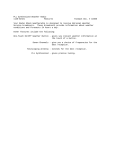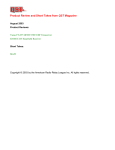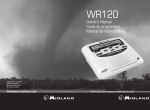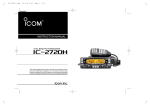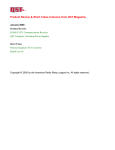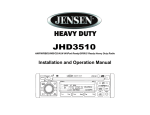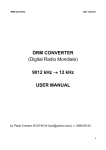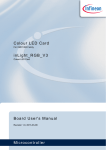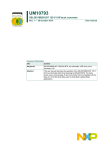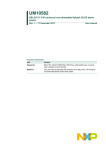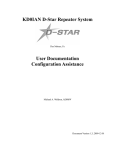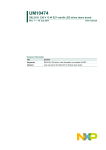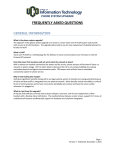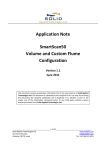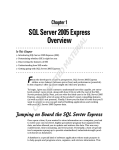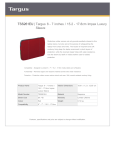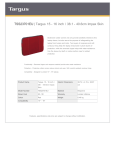Download March, 2003 Product Reviews and Short Takes
Transcript
PRODUCT REVIEW ICOM IC-2720H Dual-Band FM Transceiver Reviewed by Steve Ford, WB8IMY QST Editor The IC-2720H is the latest entry in a well-populated field of dual-band FM mobile rigs. To stand out among competing transceivers, a radio has to offer features designed to entice Amateur Radio buyers. The IC-2720H does this by combining an interesting lineup of bells and whistles with ease of operation and enough output power (maximum 50 W on 144 MHz; 35 W on 440 MHz) for just about any application. The IC-2720H also sports an interesting physical design. Lots of mobile transceivers offer detachable front panels, but in the ’2720H the front panel is detached permanently (although it can be mounted to the main unit with the MB85 combination bracket, sold separately). The main unit—the “guts” of the IC2720H—is a compact 5 × 1.5 × 7.5-inch brick outfitted with various connectors. The front panel is about the size of a chocolate bar and is connected to the main unit with an 11-foot separation cable. You can plug the backlit multifunction microphone (a de facto controller unto itself) into the front panel or directly into the main unit if you can live without a frequency readout. The mobile operating advantage of this arrangement is obvious: The IC-2720H can find a home in any conceivable vehicle. Using the ’2720H as a base unit is more of a challenge, but who is to say that you couldn’t mount the front panel on a desk with the main unit tucked out of sight? About that Front Panel The ’2720’s front-panel LCD displays frequencies for two bands. You can display 144 and 440 MHz, or a different combination such as 144/144 MHz (two frequencies within the same amateur band) or 144 and 127 MHz (working 2meter FM while listening to the aviation band simultaneously). There are separate sets of controls for tuning, volume and squelch, as well as separate sets of backlit function keys for each band. And unlike some dual-band transceivers, the volume and squelch knobs are not concentric; they are completely separate controls. If you’ve ever cursed the ergonomics of multiband mobile rigs, you know what a blessing this is. The front-panel buttons have individual labels. In my opinion, this beats the heck out of a row of nondescript buttons with ever-changing “labels” in an LCD display nearby. Main Unit There is one SO-239 antenna jack on the rear panel of the main unit. With the built-in diplexer, only one jack is necessary. If you are using separate VHF and UHF antennas, however, you’ll need to add an external diplexer. In addition to a dc power pigtail, there are two external speaker jacks. The jack designated SP-1 outputs the audio from both bands. But if you plug another speaker into the adjacent SP-2 jack, the “left-side” audio (from whichever band is on the left side of the LCD display) will appear in the SP-1 speaker and the “right-side” audio will appear in the SP-2 speaker. On the front side you’ll find RJ45 connectors for the microphone and separation cable. There is also a 6-pin mini-DIN data connector for 1200 or 9600-baud packet. Bit-error-rate tests in the ARRL Laboratory indicated adequate packet performance at 9600 baud. See Table 1. Memories and Scanning The IC-2720H offers 212 memory channels. You can program the repeater offsets in each channel as well as 50 subaudible tones (67-254.1 Hz) for repeater systems that require them and DTMF transmit memories for autopatch access and other functions. You can also split the memory channels into 10 banks designated A-J. This is convenient when you want to group memories for repeaters in specific cities, for example. Programming the IC-2720H is straightforward. If you can program a handheld’s memories, you can program the ’2720H. The user manual offers clear instructions with a strong emphasis on Dual-Band Versatility As I’ve mentioned previously, you Bottom Line Dual-band operation and widerange receive combine to make the compact IC-2720H an attractive mobile transceiver Brennan Price, N4QX From March 2003 QST © ARRL have the option of configuring the dualband capability of the ’2720H to suit your interest du jour. This rig offers wide receive coverage: 118-550 MHz on the “left” band, and 118-174, 375-550 and 810-999 MHz (cellular blocked) on the “right” band. One combo I enjoyed was setting 440 MHz as the main band so that I could monitor my home Echolink simplex station (see my article “VoIP and Amateur Radio” in the February 2003 issue of QST). I then set the sub-band for my favorite 2-meter repeater so that I could flip-flop one or the other as the need arose. One push of a button changes the main/sub-band assignment. You can only transmit from the main band. This dual-band flexibility also means that you can work the FM repeater satellites such as UoSAT-OSCAR 14 and AMRAD-OSCAR-27. More about this later. Assistant Technical Editor [email protected] Table 1 ICOM IC-2720, serial number 01024 Manufacturer’s Claimed Specifications Measured in the ARRL Lab Frequency coverage: Receive, 118-550, 810-1000 MHz (cell blocked); transmit, 144-148, 430-450 MHz. Receive and transmit, as specified. Power requirement: Receive, 1.58 A (max audio); transmit, 12 A (high power). Receive, 0.76 A; transmit, 9.1 A. Tested at 13.8 V. Modes of operation: FM, AM (receive only). As specified. Receiver Receiver Dynamic Testing AM Sensitivity, 10 dB S/N: 118-160 MHz, 0.45 µV; 220-260 MHz, 0.79 µV; 260-350 MHz, 5.6 µV; 350-375 MHz, 1.0 µV; 375-400 MHz, 0.63 µV. AM, 10 dB S+N/N: 120 MHz, 0.59 µV. FM sensitivity, 12 dB SINAD: left band, 118-160 MHz, 0.18 µV; 160-180, 220-260, 350-375 MHz, 500-550 MHz, 0.32 µV; 180-220, MHz, 3.5 µV; 260-350 MHz, 3.2 µV; 375-430, 450-500 MHz, 0.22 µV; 430-450 MHz, 0.18 µV; right band, 118-160 MHz, 0.18 µV; 160-174 MHz, 0.2 µV; 375-430, 450-550 MHz, 0.22 µV; 430-450 MHz, 0.18 µV; 810- 880 MHz, 0.45 µV; 880-1000 MHz, 1.0 µV. For 12 dB SINAD, 144 MHz, 0.14 µV; 222 MHz, 0.2 µV; 430 MHz, 0.16 µV; 902 MHz, 0.86 µV. FM adjacent channel rejection: Not specified. 20 kHz channel spacing: 146 MHz, 68 dB; 440 MHz, 62 dB. FM two-tone, third-order IMD dynamic range: Not specified. 20 kHz channel spacing: 146 MHz, 61 dB; 440 MHz, 62 dB*; 10 MHz channel spacing: 146 MHz, 78 dB; 440 MHz, 73 dB. FM two-tone, second-order IMD dynamic range: Not specified. 71 dB. S-meter sensitivity: Not specified. S9 indication: 146 MHz, 2.0 µV; 440 MHz, 2.3 µV. Squelch sensitivity: < 0.13 µV. At threshold: 146 MHz, 440 MHz, 0.09 µV. Receiver audio output: 2.4 W at 10% THD into 8 Ω. 2.9 W at 10% THD into 8 Ω. Spurious and image rejection: 60 dB. First IF rejection1, 146 MHz, 123 dB; 440 MHz, 132 dB; Image rejection1, 146 MHz, 99 dB; 440 MHz, 68 dB. Transmitter Transmitter Dynamic Testing Power output (H/M/L), 144 MHz: 50/15/5 W; 430 MHz, 35/15/5 W. 146 MHz, 53/15.3/4.4 W; 440 MHz, 35/14.6/5.2 W. Spurious-signal and harmonic suppression: 60 dB. VHF, 70 dB; UHF, 67 dB. Meets FCC requirements for spectral purity. Transmit-receive turn-around time (PTT release to 50% audio output): Not specified. S9 signal, 146, 440 MHz, 175 ms. Receive-transmit turn-around time (tx delay): Not specified. 146, 440 MHz, 60 ms. Bit-error rate (BER), 9600-baud: Not specified. 146 MHz: Receiver—BER at 12 dB SINAD, 5.0×10–4; BER at 16 dB SINAD, <1.0×10–5; BER at –50 dBm, <1.0×10–5; transmitter—BER at 12 dB SINAD, 4.4×10–3; BER at 12 dB SINAD + 30 dB, 1.0×10–3. 440 MHz: Receiver—BER at 12 dB SINAD, 1.0×10–4; BER at 16 dB SINAD, <1.0×10–5; BER at –50 dBm, <1.0×10–5; transmitter—BER at 12 dB SINAD, 9.2×10–4; BER at 12 dB SINAD + 30 dB, 2.0×10–4. Size (height, width, depth): main unit, 1.6×5.5×7.4 inches; weight, 2.8 pounds; remote head, 2×5.5×1 inches; weight, 5.3 ounces. Note: Unless otherwise noted, all dynamic range measurements are taken at the ARRL Lab standard spacing of 20 kHz. *Measurement was noise-limited at the value indicated. 1 Worst case for left and right bands. manipulating the multifunction microphone. There are several types of scanning options available, plus four scan-resume conditions to choose from. With the broad receive coverage, this makes the ’2720H a more-than-competent scanner. I should note that the ’2720H can also scan for subaudible CTCSS tones. That’s handy when you need to figure out which CTCSS frequency a repeater system is using. There is also DTCS decoding and encoding for paging applications with the “pocket beep” function to give you an audible and visual indication of an incoming call. More Bells and Whistles There are more clever goodies in the IC-2720H that bear mentioning. You can change the display color from amber to green (I preferred the default amber). Brightness is variable, too. The ’2720H defaults to the AM mode when you tune into the aviation band, but you can also select the AM mode manually for the odd AM signal you may encounter elsewhere. The IC-2720H includes the weatheralert feature found in other recent ICOM models. When you enable this function, the From March 2003 QST © ARRL radio will scan through the 162-MHz NOAA Weatheradio broadcasts every five seconds. If a station transmits a weather alert tone, an “alert” message will appear on the display. This feature works well except for the fact that it causes an audio dropout at 5-second intervals on the frequency you are monitoring. That’s a small price to pay for the ability to stay on top of weather alerts, especially if you live in an area where they occur frequently. With the cloning function you can swap memories with another IC-2720H or—and this was the feature I liked—load data into the ’2720H’s memories from your PC. You’ll need the optional CS2720 software and OPC-478 cable to do this. Operating Impressions If you don’t intend to install the main unit nearby, you’ll probably have to attach external speakers to adequately hear the IC-2720H. You can rely on the speaker ensconced in the main unit, but you’ll enjoy greater fidelity (and intelligibility) with external speakers. In my installation I put the ’2720H under the driver’s side seat and found that the audio from the main unit couldn’t quite overcome the ambient road noise. From March 2003 QST © ARRL Figure 1—Close-up view of the IC-2720H’s microphone, a control panel in itself. Users who, for some reason, really don’t need a display may plug the microphone directly into the main unit, bypassing the stand-alone control panel. An external speaker cured the problem in short order. The main chassis has a flow-through cooling design with a sizeable fan. I noticed that the fan was extremely quiet. The multifunction microphone is a clever feature, but it took me a while to master. It was just as easy to reach out and adjust the front-panel controls. To each his own—depending on the constraints of the installation, of course. Signal reports received while using the IC-2720H were consistently good. The transmit audio has plenty of punch and the RF output is more than sufficient for both close-in and fringe locations. The dual-band aspect of the IC-2720H makes it a joy to use for more than just terrestrial conversations. While driving to work one morning in December, I heard the UoSAT-OSCAR 14 satellite downlink on 435.070 MHz. I switched the main band to 2 meters and dialed up 145.975 MHz, the UO-14 uplink frequency. With just 15 W to a dual-band mobile antenna, I easily worked K8WYT in Iowa, along with several other stations. I continued to listen to a full-quieting signal from the satellite for nearly 10 minutes. That’s pretty darn good for a mobile radio! Manufacturer: ICOM America, 2380116th Ave NE, Bellevue, WA 98004; tel 425-454-8155; fax 425-454-1509; www.icomamerica.com. Suggested list price: $479.99. IC-CS-2720 software: $45. IC-OPC-478 programming cable: $45.



